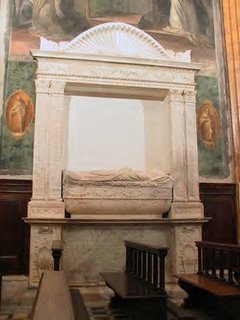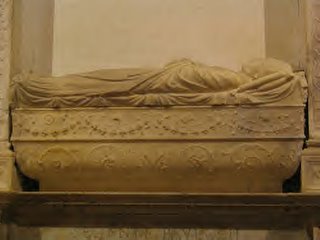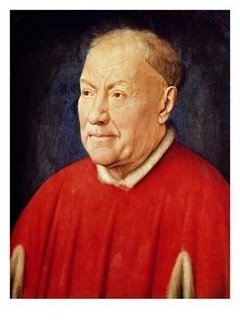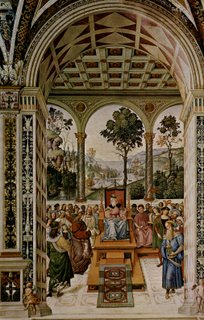Van Eyck, Jan
Portrait of Cardinal Nicolas Albergati 1431-32
Oil on panel 34 x 27.5 cm
Kunsthistorisches Museum, Vienna
Portrait of Cardinal Nicolas Albergati 1431-32
Oil on panel 34 x 27.5 cm
Kunsthistorisches Museum, Vienna
Arriving at the Council of Basle in the service of Bishop Domenico Capranica, Aeneas quickly discovered that his talents could be more amply recognised and rewarded elsewhere and in the service of more wealthy and powerful patrons.
He left the service of Capranica for Nicodemo della Scala, Bishop of Freising, then with Bartolomeo, Bishop of Novara, and finally with Cardinal Albergati. He accompanied Albergati on several journeys, particularly to the Congress of Arras, which in 1435 discussed peace between Burgundy and France. He appears to have been recognised by Albergati as a trusted aide.
In 1435 Albergati sent him on a secret mission to Scotland. The nature of the mission is not revealed even in his Commentaries. He was not permitted to travel overland to Scotland through England. Whatever the purpose of the visit was, it involved Piccolomini in great difficulty, including being shipwrecked in a storm.
Pinturicchio, Fresco in the Piccolomini Library in the Duomo at Siena showing Aeneas in the Court of the King of Scotland [1502-1507]
When he returned from Scotland, Cardinal Albergati was no longer at Basle. But Piccolomini decided to remain at the Council. The Council gave him various appointments of importance.He continued to side with the opposition to Pope Eugene IV, and associated particularly with a small circle of friends who worshipped classical antiquity and led dissolute lives.
He declined to receive Holy Orders, however, and shrank from the ecclesiastical state because of the obligation of continence which it imposed. Even the inducement to become one of the electors of a successor to Eugene IV, unlawfully deposed, does not appear to have been able to overcome this reluctance. Rather than receive the diaconate he refused the proffered honour.
However he was still involved in the conclave and in the politics of the Council. He was appointed master of ceremonies to the conclave which elected Amadeus of Savoy to the papacy.
Amadeus of Savoy, anti-Pope Felix V, the last of the anti-Popes
He likewise belonged to the delegation which was to escort to Basle in 1439 the newly-elected antipope, who assumed the name of Felix V. Felix chose Piccolomini as his secretary.
Despite this, Aeneas realised that the winds were beginning to change. The party of the schismatics was no longer ascendant but in decline. Whilst an envoy of the Council at the Diet of Frankfurt in 1442, he again changed allegiance. His literary attainments were brought to the attention of the Emperor Frederick III, who crowned him imperial poet, and offered him a position in his service which was gladly accepted.
On 11 November 1442, Piccolomini left Basle for Vienna, where he assumed the duties of secretary in the Imperial Chancery in January 1443. Receding gradually from his attitude of supporter of anti-pope Felix V, he enjoyed the patronage of the Imperial Chancellor Schlick, a partisan of Pope Eugene IV.
Notes and Links:
(1) Cardinal Domenico Capranica
THOMAS J. SHAHAN Transcribed by Gerald M. Knight The Catholic Encyclopedia, Volume III Copyright © 1908 by Robert Appleton Company Online Edition Copyright © 2003 by K. Knight
"Cardinal, theologian, canonist, and statesman.
Born at Capranica near Palestrina, Italy, in 1400; died at Rome, 14 July, 1458.
After brilliant studies in canon and civil law at Padua and Bologna, under such teachers as the later Cardinals Giuliano Cesarini and Nicholas of Cusa, he received the title of Doctor of Both Laws at the age of twenty-one.
Soon he became secretary to Martin V, and Apostolic Prothonotary, and in 1423 or 1426 was made cardinal in petto by this pope, though his nomination was not published in secret consistory until 1430. He had earned this rapid promotion by various political and military services, notable by his administration of Imola and Forli and by his successful reduction of rebellious Bologna. In the meantime he had become Bishop of Fermo, but for some reason did not go to Rome for the public ceremonies of the cardinalate.
Despite his protest, and their previous agreement with Martin V, the cardinals of the conclave that followed the latter's death (1431) refused to recognize Capranica's nomination, and the new pope, Eugene IV, sustained their decision on the ground that the delivery of the hat and assignment of the title were necessary for the validity of a cardinalitial nomination. Capranica, having already suffered severe losses at Rome through the enmity of the Orsini, took refuge first with the Visconti of Milan and later appealed (1432) to the Council of Basle for recognition of his title. This was granted, but to punish him for adhering to the Council Eugene IV deprived him of all honours and dignities, also of all his possessions.
Capranica, then served by Æneas Sylvius as secretary, bore himself with moderation and caution, and soon sought a reconciliation with the Pope at Florence (30 April, 1434), who restored to him his offices and goods, gave him the cardinalitial Title of Santa Croce in Gerusalemme, and sent him to the Council at Ferrara, with special commission to treat with the Greek bishops and theologians concerning the reunion of the Churches.
He frequently administered important departments of the States of the Church, always with justice, prudence, and integrity. He executed twelve responsible embassies for the Apostolic See, and was named (1449) Grand Penitentiary and Archpriest of the Lateran.
Capranica was one of the most earnest reformers in the Roman Church, inaugurated the restoration of primitive fervour among the Cistercians of Tuscany, and drew up for Nicholas V, in 1449, a model plan of a general religious reformation (Pastor, Gesch. d. Päpste, 4th ed. I, 394-96).
He was extremely stern and severe in character, and in the duties of his office open and free of speech, also quite fearless. He insisted on a personal examination of the votes cast for Nicholas V, whose election greatly surprised him, and remonstrated vigorously with Callistus III for his nepotism, especially in the nomination of Don Pedro Luis Borgia as Vicar (governor) of Spoleto (Pastor, op. cit., tr. II, 461).
While very liberal to the poor, on the other hand he was austere and rigid towards the worldly prelates of the city and was wont to freely reproach them. His household was a model for correctness and simplicity of life. Capranica was eminent as a peacemaker, notable at Genoa, where he healed grievous municipal dissensions, and again between the Apostolic See and King Alfonso of Naples and the princes of Germany.
During the plague of 1456 he remained at Rome when many others fled. He took a very prominent part in all the negotiations for a crusade against the Turks in the hope of restoring Constantinople to the Palæologi. To posterity he is best known as the founder of the Collegio Capranica which he opened in his own palace (the oldest Roman monument of the early Renaissance) for thirty-one poor scholars, sixteen in theology and the liberal arts, and fifteen in canon law. Its constitutions, drawn up by himself (Rome, 1705, 1879), are praised as a model of their kind; the college itself is the oldest of the Roman colleges and therefore rejoices in the peculiar title of "Almo Collegio".
In 1460 his brother Cardinal Angelo Capranica erected nearby a special building for the college (Denifle, Die Universitäten, I, 317 sqq.).
He left all his property to ecclestiastical uses, saying: "The Church gave it to me; I give it back, for I am not its master, but its steward. I should indeed have reaped but little profit from the nights spent in studying ecclesiastical discipline if I were to leave to my relatives the goods of the Church which belong to the poor" (Pastor, op. cit. II, 492)
At his death the Milanese ambassador wrote home that "the wisest, the most perfect, the most learned, and the holiest prelate whom the Church has in our days possessed is gone from us". He added that he was universally considered as the next pope (op. cit. II, 494). Pastor himself says that of all the cardinals of the Renaissance Age none but Albergati, Cesarini, and Carvajal can be compared with him (ibid., 495).
He lies buried in Santa Maria sopra Minerva, near St. Catherine of Siena.
He wrote an excellent opusculum known as "The Art of Dying Well" printed in 1487. In his life by Catalanus are some notes on the Council of Basle, and he is said by Mansi (in Moroni) to have written a history of that council, never printed. He also drew up for the instruction of his nephew certain "Rules of Life" that Pastor says reflect his beautiful character. "


Sarcophagus of Cardinal Domenico Capranica in Santa Maria Sopra Minerva, Rome
(2) Cardinal Albergati
Cardinal and Bishop of Bologna, b. at Bologna in 1357; d. at Sienna, 9th May, 1443. He entered the Carthusian Order in 1394, served as prior in various monasteries, and was made Bishop of Bologna, against his will, in 1417. In this office he still followed the Rule of his Order, was zealous for the reform of regular and secular clergy, and was a great patron of learned men, among whom was Aeneas Sylvius, afterwards Pius II.
Martin V and his successor, Eugenius IV, employed him on several important missions, thrice to France (1422, 1431, 1435), and thrice to Lombardy (1426, 1427, 1430). He was made a Cardinal in 1426. attended the Council of Basle in 1432, and again in 1434 and 1436, as legate of Eugenius IV, a position which he also filled in January 1438, at Ferrara, whither Eugenius had transferred the Synod. He took part in the conferences with the Greeks in preparation for the union effected at Florence. The Pope appointed him Grand Penitentiary shortly before his death. Though never formally canonized, he has long been popularly venerated as Blessed (Acta SS., II May, 469 sqq., and Analecta Boll., VIII, 381 sqq.). He is the author of various theological and other treatises, including: "Recollecta multae electionis"; "Apologia pro Eugenio IV"; sermons, prayers, epistles (P.L., CCIV). His life has been written by many different authors, contemporary and since his time.
(3) Amadeus of Savoy, anti-pope Felix V
Born 4 December, 1383, died at Ripaille, 7 January, 1451. The schismatic Council of Basle, having declared the rightful pope, Eugene IV, deposed, proceeded immediately with the election of an antipope.
Wishing to secure additional influence and increased financial support, they turned their attention towards the rich and powerful prince, Duke Amadeus VIII of Savoy. Amadeus had exercised over his dependencies a mild and equitable sway, and had evinced a great zeal for the interests of the Church, especially in connection with the Western Schism regarding the papal succession, brought to a close by the Council of Constance.
Emperor Sigismund had shown his appreciation of this ruler's services by raising, in 1416, the former counts of Savoy to the status of a duchy, and in 1422 conferred on Amadeus the county of Geneva. On the death of his wife, Maria of Burgundy, Duke Amadeus resolved to lead henceforth a life of contemplation, without however entirely resigning the government of his territories. He appointed his son Ludwig regent of the duchy, and retired to Ripaille on the Lake of Geneva, where in company with five knights whom he had formed into an Order of St. Maurice, he led a semi-monastic life in accordance with a rule drawn up by himself.
Amadeus had been in close relations with the schismatic council of Basle; and was elected pope, 30 October, 1439, by the electoral college of that council, including one cardinal (d'Allamand of Aries), eleven bishops, seven abbots, five theologians, and nine canonists. After long negotiations with a deputation from the council, Amadeus acquiesced in the election, 5 Feb., 1440, completely renouncing at the same time all further participation in the government of his duchy. Ambition and a certain fantastic turn of character induced him to take this step.
Amadeus had been in close relations with the schismatic council of Basle; and was elected pope, 30 October, 1439, by the electoral college of that council, including one cardinal (d'Allamand of Aries), eleven bishops, seven abbots, five theologians, and nine canonists. After long negotiations with a deputation from the council, Amadeus acquiesced in the election, 5 Feb., 1440, completely renouncing at the same time all further participation in the government of his duchy. Ambition and a certain fantastic turn of character induced him to take this step.
He took the name of Felix V, and was solemnly consecrated and crowned by the Cardinal d'Allamand, 24 July, 1440. Eugene IV had already excommunicated him, 23 March, at the council of Florence.
Until 1442, the famous Aeneas Sylvinus Piccolomini, later Pius II, was the antipope's secretary. This renewal of the schism ruined any success of Basle assembly, just closed at Constance.
Subsequently, Amadeus took up his residence in Savoy and Switzerland; his efforts to surround himself with a curia met with little success; many of those whom he named cardinals declined the dignity.
He found general recognition only in Savoy and Switzerland, but his claims were also recognized by the Dukes of Austria, Tyrol, and Bayern-München, the Count-Palatine of Simmern, the Teutonic Order, some orders in Germany and some universities hitherto adherents of Basle. He was soon embroiled in a quarrel with the Council of Basle concerning his rights and the distribution of revenues. The rightful pope, Eugene IV, and his successor Nicolas V (1447), who were universally recognized from the first in Spain and Poland, found their claims even more widely admitted in France and Germany. In 1442, Felix left Basle, and on 16 May, 1443, occurred the last session of the Baste assembly. Felix, who had for the sake of its revenue assumed the administration of the Diocese of Geneva, clung for six years more to his usurped dignity but finally submtted (1449) to Nicolas V, received the title of Cardinal of St. Sabina, and was appointed permanent Apostolic vicar-general for all the states of the House of Savoy and for several dioceses (Basle, Strasburg, Chur, etc.). Thus ended the last papal schism.
www./en.wikipedia.org/wiki/Amadeus_VIII_of_Savoy
www./en.wikipedia.org/wiki/Amadeus_VIII_of_Savoy
(4) Frederick III
1415-93, Holy Roman emperor (1452-93) and German king (1440-93).
With his brother Albert VI he inherited the duchies of Styria, Carinthia, and Carniola. He became head of the house of Hapsburg at the death (1439) of his distant cousin Albert II, whom he was elected (1440) to succeed as German king.
Although Frederick was generally a weak ruler, he made considerable progress toward reuniting the Hapsburg family lands under his own branch.
On Albert II's death Frederick became guardian for his young son Ladislaus Posthumus (see Ladislaus V ) and regent of Austria for Ladislaus. In Bohemia and Hungary, however, he was unable to establish himself as regent for Ladislaus. In 1453 he temporarily lost Austria when he was forced to give up the youth. After the death (1457) of Ladislaus, Frederick relinquished Bohemia to George of Podebrad and Hungary to Matthias Corvinus .
In Austria, his succession to Ladislaus as duke was challenged by his brother, but Albert's death (1463) left Frederick with an undisputed claim. In 1485, Matthias Corvinus, who had invaded Bohemia and Austria, occupied Vienna, and Frederick was forced to abandon his hereditary lands.
However, longevity again proved an advantage; Matthias died in 1490, and Frederick recovered his possessions. In his relations with the Roman Catholic Church, Frederick was guided by his secretary, the brilliant Aeneas Silvius Piccolomini (later Pope Pius II ). In return for his support of Pope Eugene IV against Antipope Felix V (see Amadeus VIII ), Frederick was promised an imperial coronation at Rome and various subsidies and revenues. He was the last emperor crowned at Rome.
Frederick's greatest success was his acquisition of Burgundy, including the Netherlands and Belgium, for the house of Hapsburg.
In 1473 at an interview at Trier with Charles the Bold of Burgundy, Frederick attempted to arrange the marriage of his son, later King Maximilian I , to Charles's daughter Mary of Burgundy.
However, he was not prepared to meet Charles's demands and the negotiations ended abruptly. In 1477, soon after the defeat and death of Charles at Nancy, the marriage of Maximilian and the Burgundian heiress nevertheless took place and netted Austria a huge and cheap prize.
This alliance set the pattern for the subsequent marriages and successions through which the Hapsburgs came to dominate a large part of the globe.
In 1486, Maximilian was elected king of the Romans, or German king, and after 1490, Frederick resigned most of his duties to his son.
The anagram AEIOU, inscribed on Frederick's personal possessions, has traditionally been explained as signifying Austria est imperare orbi universo [Lat.,=it is Austria's destiny to rule the whole world] or Alles Erdreich ist Österreich untertan [Ger.,=all the earth is subject to Austria].



